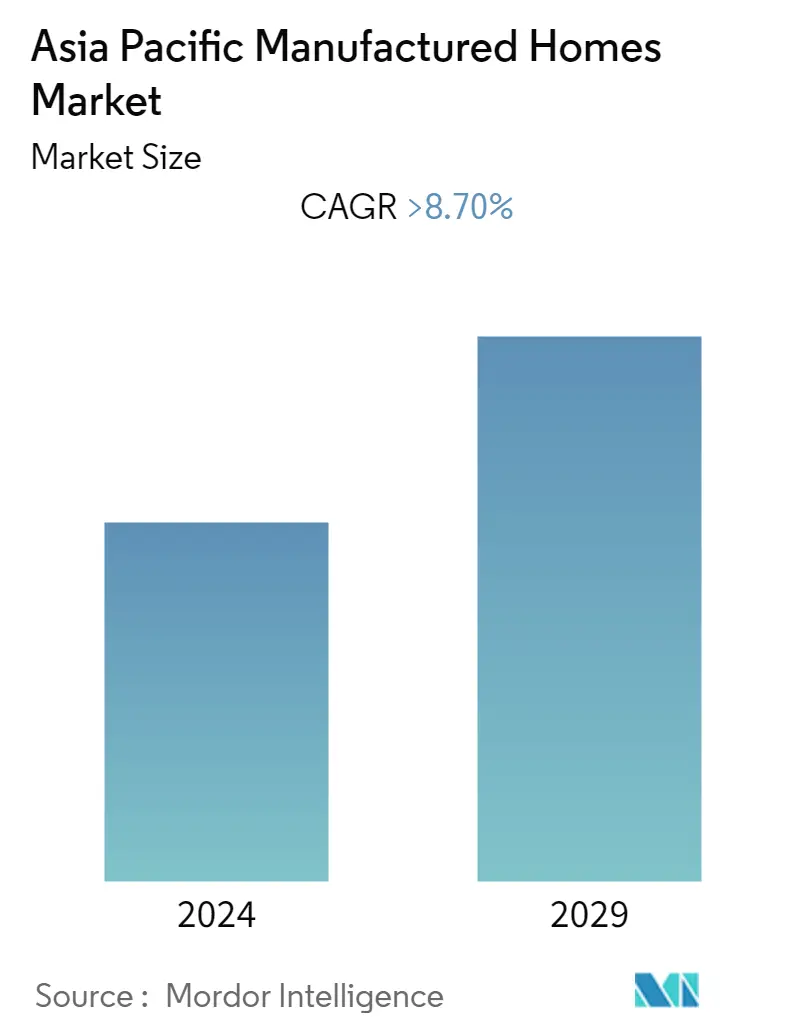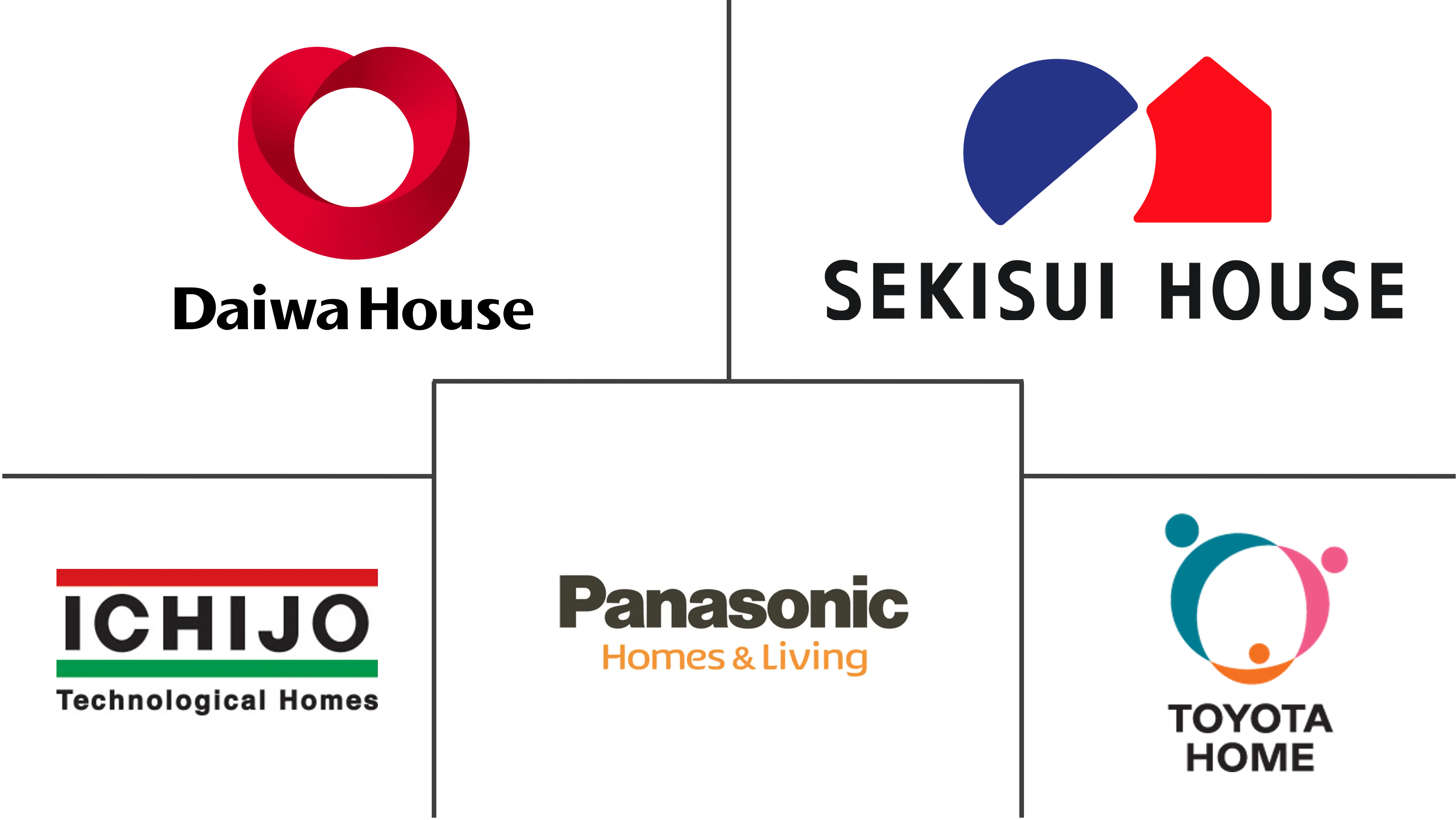Market Size of Asia Pacific Manufactured Homes Industry

| Study Period | 2020 - 2029 |
| Base Year For Estimation | 2023 |
| Forecast Data Period | 2024 - 2029 |
| Historical Data Period | 2020 - 2022 |
| CAGR | 8.70 % |
| Market Concentration | Medium |
Major Players
*Disclaimer: Major Players sorted in no particular order |
APAC Manufactured Homes Market Analysis
Asia Pacific Manufactured Homes Market is USD 20 billion in the current year estimated to register a CAGR of over 8.70% during the forecast period.
- The other motivating aspect will be the growing worries about green infrastructure and sustainable living to meet the needs of the expanding population. There are particular situations where the need for modular housing is more urgent. Manufactured homes can provide low-cost housing for low-income communities in Asia while safeguarding them from calamities and harsh conditions.
- The luxury market is currently presenting prefabricated homes as more than just a straightforward dwelling solution, both in the Asia Pacific and the West. High-end modular home designers are increasingly seeking inspiration outside of the West. The most lucrative market for manufactured building systems is anticipated to be Asia Pacific, and this trend is likely to stay for the foreseeable future. The market for modular homes has significantly increased over the past few years in Asia Pacific nations including China, South Korea, and India. This is giving the market for sustainable building systems a solid boost.
- Due to the rapidly rising demand from the residential sectors of India, China, and Japan, the Asia-Pacific manufactured home market is predicted to have considerable expansion over the forecast period. The Asia-Pacific manufactured homes market is expected to increase rapidly as a result of significant investments made by China and India in the development of their infrastructure.
APAC Manufactured Homes Industry Segmentation
The manufactured homes, sometimes also called mobile homes, are constructed offsite, and once the entire structure is completed, the final product is transported to the desired location. The offsite works also include plumbing works, electrical works, installing the air conditioners, wiring, etc. The Asia Pacific Manufactured Homes Market is segmented by Type (Single Family and Multi-Family), and Geography. The report offers market size and forecasts for the Asia Pacific Manufactured Homes Market in value (USD billion) for all the above segments.
| Type | |
| Single Family | |
| Multi Family |
Asia Pacific Manufactured Homes Market Size Summary
The Asia Pacific manufactured homes market is experiencing significant growth, driven by increasing demand for affordable and sustainable housing solutions. This trend is particularly evident in countries like China, South Korea, and India, where the need for modular housing is urgent due to rapid urbanization and population growth. Manufactured homes are being recognized as a viable option for low-income communities, offering protection against natural disasters and harsh conditions. The luxury segment is also evolving, with high-end modular home designers drawing inspiration from both Eastern and Western influences. This has positioned the Asia Pacific region as a lucrative market for manufactured building systems, with substantial investments in infrastructure development further propelling market expansion.
In Australia, the government and not-for-profit organizations are actively working to increase the supply of affordable homes through financial incentives and regulatory support. Despite challenges in securing adequate funding, initiatives like the collaboration lab for prefabricated buildings and investments in advanced manufacturing training centers are expected to enhance the sector's capabilities. Meanwhile, Japan's manufactured home industry is a global leader in innovation, with a strong focus on consumer engagement and high-quality designs. The market is characterized by fierce competition, with major players like Daiwa House Industry and Sekisui House leading the charge. These companies are expanding their influence by entering new markets and exploring diverse housing options, such as wooden housing, to meet evolving consumer preferences.
Asia Pacific Manufactured Homes Market Size - Table of Contents
-
1. MARKET DYNAMICS AND INSIGHTS
-
1.1 Current Market Scenario
-
1.2 Market Dynamics
-
1.2.1 Drivers
-
1.2.2 Restraints
-
1.2.3 Opportunities
-
-
1.3 Industry Value Chain Analysis
-
1.4 Technological Innovations in the Manufactured Homes Market
-
1.5 Government Regulations and Initiatives in the Industry
-
1.6 Insights into Manufactured House Costs
-
1.7 Industry Attractiveness - Porter's Five Forces Analysis
-
1.7.1 Threat of New Entrants
-
1.7.2 Bargaining Power of Buyers/Consumers
-
1.7.3 Bargaining Power of Suppliers
-
1.7.4 Threat of Substitute Products
-
1.7.5 Intensity of Competitive Rivalry
-
-
1.8 Impact of the COVID-19 on the Market
-
-
2. MARKET SEGMENTATION
-
2.1 Type
-
2.1.1 Single Family
-
2.1.2 Multi Family
-
-
Asia Pacific Manufactured Homes Market Size FAQs
What is the current Asia Pacific Manufactured Homes Market size?
The Asia Pacific Manufactured Homes Market is projected to register a CAGR of greater than 8.70% during the forecast period (2024-2029)
Who are the key players in Asia Pacific Manufactured Homes Market?
Daiwa House Industry, Sekisui House, Ichijo, Panasonic Homes and Toyota Housing Corporation are the major companies operating in the Asia Pacific Manufactured Homes Market.

